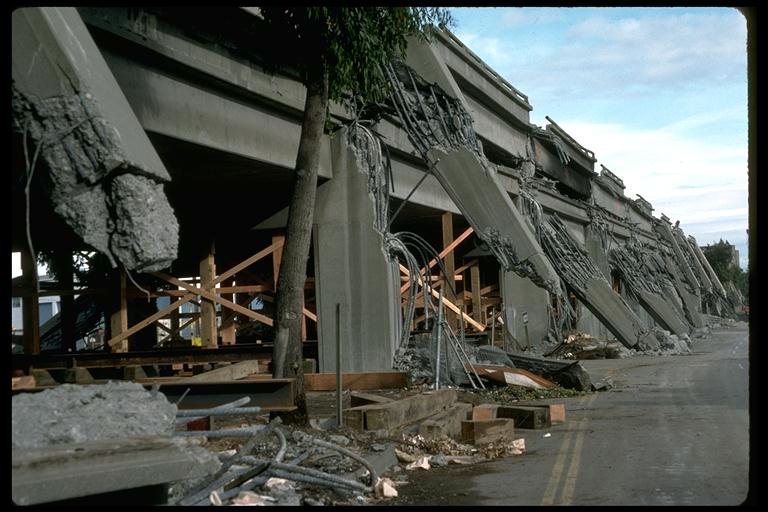
Image by H.G. Wilshire, U.S. Geological Survey.
The primary effects of earthquakes are ground shaking, ground rupture, landslides, tsunamis, and liquefaction. Fires are probably the single most important secondary effect of earthquakes.
Below is an image of the Cypress viaduct which was part of Interstate 880 in Oakland, CA. The upper level of the two-level structure has collapsed onto the lower level as a result of failure of the support columns. The columns failed partially in response to ground shaking from the 17 October 1989 Loma Prieta earthquake amplified by loose sediments near the Oakland waterfront. 41 people were killed in the collapse.

Image by H.G. Wilshire, U.S. Geological Survey.
Below is an image from the Marina District in San Francisco. The Marina District is built on Bay mud which was pumped onto the San Francisco waterfront for the 1915 Pan-American Exposition. This fill both underwent liquefaction (see below) and considerably amplified ground shaking from the Loma Prieta earthquake. These factors together led to the collapse of many houses and apartment buildings in the Marina District.
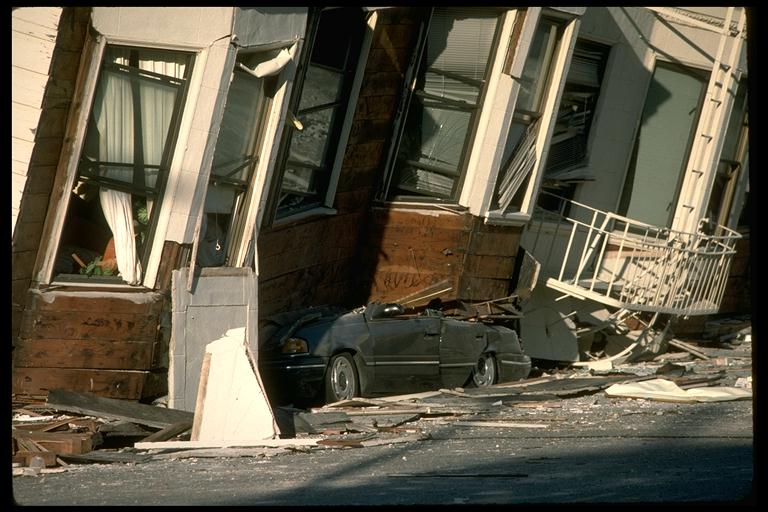
Image by J.K. Nakata, U.S. Geological Survey.
Ground rupture is another important effect of earthquakes which occurs when the earthquake movement along a fault actually breaks the Earth's surface. While active ground rupture is comparatively rare, there have been cases of it in California -- for example, during the 1906 earthquake, fences near Pt. Reyes were offset by as much as 7 meters. And in the Owens Valley earthquake in 1872, a fault scarp as much as 8 meters high broke the ground near Lone Pine. Rupture causes problems for humans by, well, rupturing things; pipelines, tunnels, aqueducts, railway lines, roads, and airport runways which cross an area of active rupture can easily be destroyed or severely damaged.
Below is a classic picture of a scarp formed by the 16 December 1954 Dixie Valley earthquake (magnitude 6.8) in Nevada. The miner's shack next to the scarp was relatively undamaged, despite being only a few meters from the two- to three-meter offset.
Image by Karl V. Steinbrugge.
Landslides are caused by earthquakes both by direct rupture and by sustained shaking of unstable slopes. They can easily destroy buildings in their path, or block roads and railroad lines, or take hilltop homes with them as they tumble. They even can dam rivers on occasion, like in the 17 August 1959 Hebgen Lake (magnitude 7.1) earthquake in Montana.
Below is an image of a large landslide which fell across Highway 17 in the Santa Cruz Mountains after the Loma Prieta earthquake. The concrete blocks in the foreground are broken chunks of the center divider on the highway. The road, which is a major commute route from Santa Cruz to the Silicon Valley, was closed for several weeks after the earthquake.
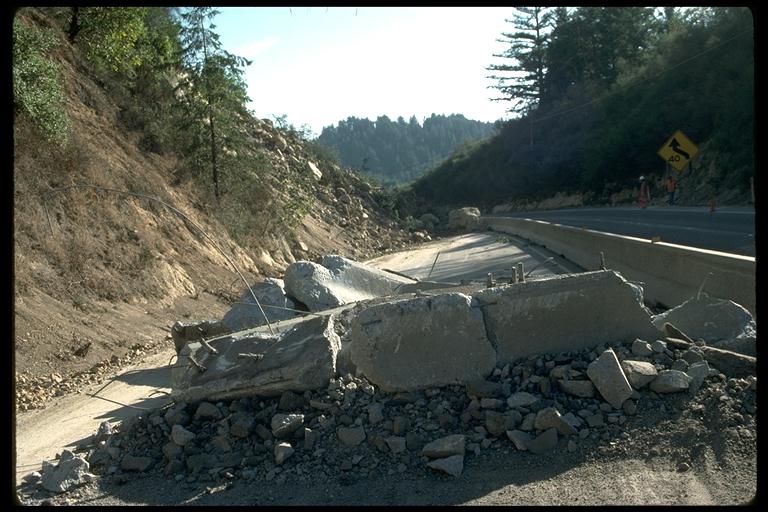
Image by C.E. Meyer, U.S. Geological Survey
Tsunamis, which are popularly -- and incorrectly -- known as ``tidal waves'', are a grave hazard to many parts of the world, particularly around the Pacific Ocean basin. Tsunamis are a series of water waves caused when the seafloor moves vertically in an earthquake (which is why they are extremely uncommon in California earthquakes -- most CA earthquakes are strike-slip, with little or no vertical motion) and which can travel vast distances in a short period of time. Tsunami speeds in the deep ocean have been measured at more than 700 km/hr, comparable to some jet planes, and when tsunamis reach shallow water near the coast, they can reach heights of more than 27 meters (90 feet)! Remember that tsunamis are a series of waves, and may start with a gentle withdrawal of water, followed by a very abrupt arriving wave, followed by another withdrawal, etc. The safest thing to do if you hear a tsunami is coming is to move to higher ground away from the beach as quickly as possible.
Below is an image of a tsunami striking the coast in Hilo, Hawaii. This tsunami was generated by a magnitude 7.8 earthquake in the Aleutian Islands on 1 April 1946. Here, the tsunami height is about 6 meters (20 feet).
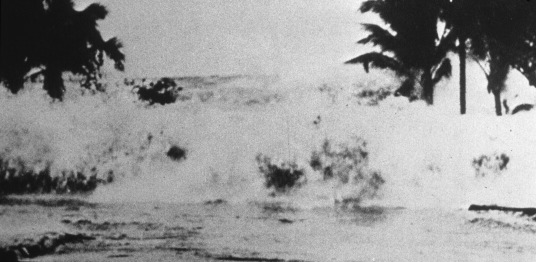
Image by Mrs. Harry A Simms, Sr.
Below is one of the most famous tsunami pictures in existence, also of the 1946 tsunami in Hilo. The picture was taken from the deck of the SS Brigham Victory in Hilo Harbor. The man in the picture (indicated by the white arrow) was killed by the wave.

Image by NOAA/EDIS
Liquefaction and subsidence of the ground are important effects which often are the cause of most of the destruction in earthquakes, particularly in unconsolidated ground. Liquefaction is when sediment grains are literally made to float in groundwater, which causes the soil to lose all its solidity. Subsidence can then follow as the soil recompacts. Sand blows, or sand volcanoes, form when pressurized jets of groundwater break through the surface. They can spray mud and sand over an area a few meters across. All of these effects pose a grave danger to buildings, roads, train lines, airport runways, gas lines, etc. Buildings have actually tipped over and sunk partway into liquefied soils, as in the 1964 Niigata earthquake in Japan. Underground gas tanks and septic tanks (yuck!) have been known to float to the surface through liquefied soils. All told, liquefaction and associated effects resulted in more than $20 billion damage in the 1995 Kobe earthquake, and similar levels of damage are possible in US port facilities during a large earthquake.
Below is a picture of the Kwangishicho Apartments in Niigata, Japan. Three of the buildings (the white ones) have tilted over due to liquefaction. One of the buildings has tilted 75° from the vertical. Despite these large tilts, the apartments were largely intact -- people were able to escape by walking down the side of the most tilted building.
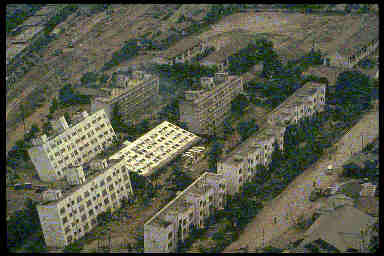
Image from CDMG.
Below is a good example of a series of sand blows. The total length of the deposit is about 6-7 meters (20-23 feet), and it resembles a system of volcanic fissures and vents in miniature. This is a good example of why sand blows are also called ``sand volcanoes''.
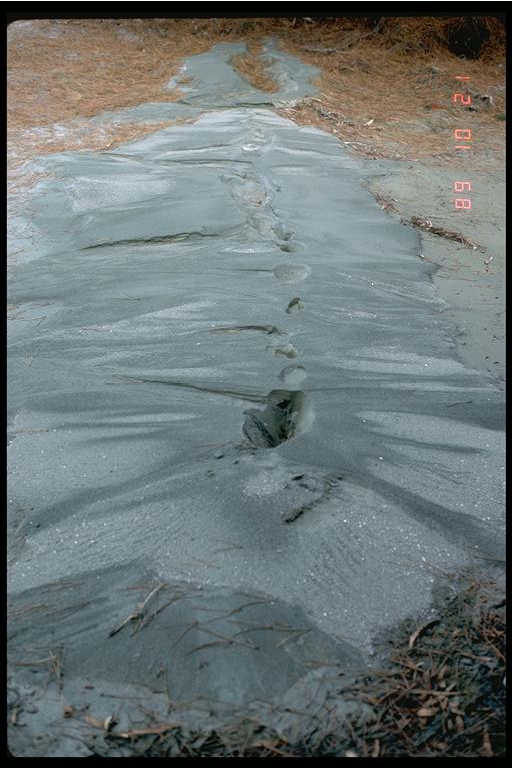
Image by J.C. Tinsley, U.S. Geological Survey.
Fires are a major source of damage after earthquakes. Ground rupture and liquefaction can easily rupture natural gas mains and water mains, both contributing to the ignition of fires and hindering the efforts to control them. In an amazing example of this, during the 1994 Northridge earthquake there were actually places where water was pouring down streets from broken water mains -- and at the same spot and same time, fire was roaring out of ruptured gas mains! Shaking also contributes to starting fires, by knocking down power lines, spilling flammable liquids from storage containers, and tossing hot coals from barbeques and stoves. In the 1923 Kwanto earthquake in Japan, for example, nearly 100,000 people died -- over 70,000 of them due to fires which swept the area after the earthquake. And of course most of the damage in San Francisco from the 1906 earthquake was caused by the subsequent fires.
Below is a terrifying image of fire after the 1994 Northridge earthquake. Here, some neighbors are struggling to help put out fires along Balboa Avenue which were sparked by a broken gas main. They are having to face the major problem of fighting a fire in an area with broken water mains as well. You may be able to imagine why fire is such a threat. (By the way, this picture won a Pulitzer Prize.)
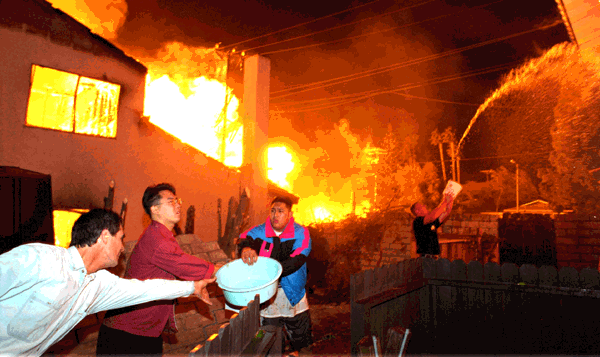
Image by Ken Lubas, Los Angeles Times
Now, with all these types of major damage, people often ascribe malevolence to earthquakes. Please keep in mind: not a single person has ever been killed directly by an earthquake. It is the fact that we humans persist in building things which are prone to failure in earthquake, and then living in and around these buildings, that results in deaths during earthquakes. Earthquakes are mindless natural phenomena; we aren't.
Greg Anderson